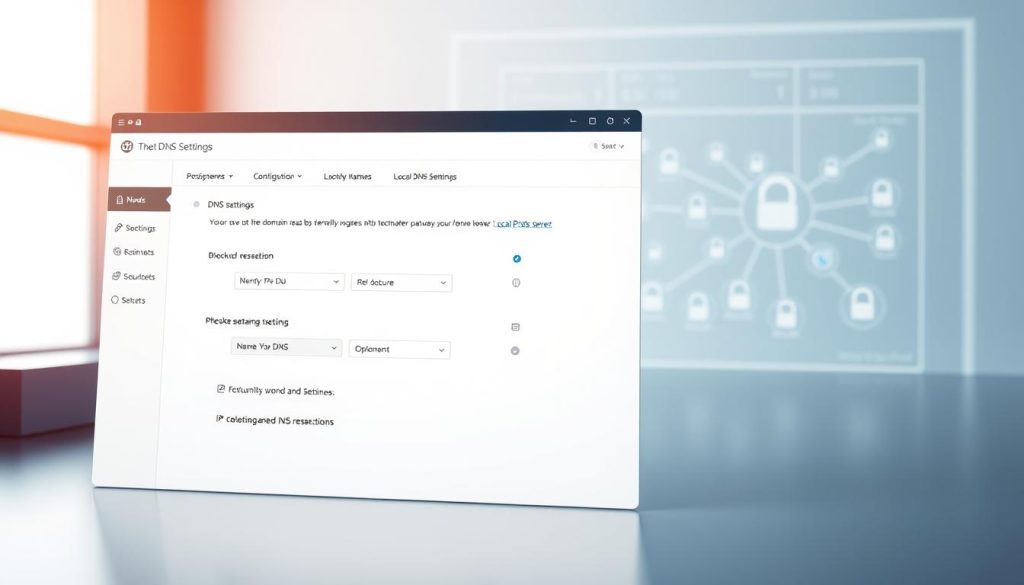Are you tired of being tracked online and seeing too many ads? Setting up a local DNS server can change your internet experience. It makes your online life more private and secure.
A DNS server setup helps block ads and trackers before they hit your devices. This makes your browsing better and safer. With a local DNS server, you control your online data better and enjoy a safer internet.
Key Takeaways
- Improve your internet security with a local DNS server.
- Block unwanted ads and trackers effectively.
- Enhance your online privacy with a DNS server setup.
- Reduce the risk of malware infections.
- Gain more control over your online data.
What is a Local DNS Server?
A local DNS server connects your device to the internet. It changes domain names into IP addresses that computers can use. This is key to accessing websites and online services.
Definition of DNS
The Domain Name System (DNS) is like the internet’s phonebook. It turns domain names into IP addresses that computers can understand. For example, when you type “example.com” in your browser, DNS changes it into an IP address like “192.0.2.1.” This lets your device find the website’s server.
Importance of Local DNS
Having a local DNS server can make your online experience better. It helps keep your data private by sharing less with third-party DNS services. Also, a local DNS server can block ads and trackers, making your browsing safer and smoother.
How DNS Works
The DNS resolution process has several steps:
- Your device sends a DNS query to the DNS resolver (your local DNS server).
- The local DNS server checks its cache for the IP address of the domain name.
- If it’s not cached, the local DNS server asks other DNS servers on the internet for the IP address.
- When it finds the IP address, it returns it to your device. This lets you access the website or service you want.
Understanding DNS and using a local DNS server can improve your online privacy and security. You’ll enjoy a faster and more private internet experience.
Benefits of Running Your Own DNS Server
Having a personal DNS server brings many benefits. It improves your privacy and speed. This makes your online experience better.
Enhanced Privacy
One big plus of running your own DNS server is enhanced privacy. It blocks trackers and ads at the DNS level. This stops your online activities from being watched.
Tools like Pi-hole show how effective this is. They block ads and trackers, boosting your privacy. With your own DNS server, you control what gets blocked and what doesn’t.

Improved Speed
Another key benefit is improved speed. Your own DNS server cuts down on DNS lookup latency. It caches responses, so you don’t have to keep asking external servers.
This makes your internet faster and more responsive. You’ll enjoy a smoother browsing experience.
Customization Options
Running your own DNS server also means customization options. You can set it up to block specific domains or redirect certain requests. This lets you tailor your DNS server to your needs.
For example, you can use it to block ads on all devices in your network. This gives you a cleaner browsing experience. You can also use it for tracking prevention to protect your online privacy.
These benefits help you create a safer, more private, and efficient online space. Whether you want better privacy, faster internet, or custom DNS settings, your own DNS server is a great choice.
Setting Up a Local DNS Server
Setting up a local DNS server can boost your internet privacy and security. It lets you block unwanted content and speed up your browsing. Plus, it keeps your data safe from third-party servers.
Hardware Requirements
To start, you need a device for your DNS server. A Raspberry Pi is a great pick because it’s cheap, uses little power, and works well for DNS. You can also use an old computer or a more powerful device for bigger networks.
Here are the main things to consider for hardware:
- A processor that’s at least 1 GHz fast
- At least 512 MB of RAM
- Enough storage for the OS and DNS software (an 8 GB SD card or more)
Software Options
There are many software options for DNS servers. Pi-hole is great for home networks because it blocks ads and is easy to use. It’s perfect for a Raspberry Pi. AdGuard DNS can be used on many devices and has advanced features for filtering and securing your DNS.
When picking software, think about these things:
- How easy it is to install and set up
- Features like ad-blocking and tracking protection
- If it works with your chosen hardware
Installation Process
The setup process depends on your software and hardware. For Pi-hole on a Raspberry Pi, you download and run a script in the terminal. It’s pretty straightforward.
For AdGuard DNS, you might need to download and install a package for your OS. The official website usually has detailed instructions.
Make sure to follow the official guide closely, no matter the software. After setting it up, you’ll need to change your router or device settings to use your new DNS server.
Blocking Ads with DNS
Using a DNS server for ad blocking is a smart way to cut down on online ads. It makes your browsing better and keeps your devices safe from malware. This method stops ads by blocking requests to ad-serving domains.
How Ad Blocking Works
Ad blocking with DNS stops ads by blocking requests to known ad servers. When you set up your DNS server for ad blocking, it checks each request. If it’s for an ad, the DNS server blocks it, so you don’t see the ad.
Popular DNS-based Ad Blockers
There are many DNS-based ad blockers out there. They offer different levels of customization and effectiveness. AdGuard DNS and Pi-hole are two of the most popular ones.
- AdGuard DNS: Known for its powerful filters that eliminate ads and trackers.
- Pi-hole: A network-wide ad blocker that can be configured on your local DNS server.
Step-by-Step Setup
To start blocking ads with your DNS server, follow these steps:
- Choose a DNS-based ad blocker that fits your needs, such as AdGuard DNS or Pi-hole.
- Configure your DNS server to use the chosen ad blocker’s filters.
- Update your device or router settings to use your DNS server.
| Feature | AdGuard DNS | Pi-hole |
|---|---|---|
| Ease of Setup | Simple configuration | Requires technical knowledge |
| Customization | Limited customization options | Highly customizable |
| Effectiveness | High ad-blocking rate | Highly effective with proper configuration |

By following these steps and picking the right DNS-based ad blocker, you can greatly reduce online ads. This makes your browsing experience much better.
Tracking Prevention with DNS
Running your own DNS server helps prevent online tracking. Advertisers and data brokers often track your online activities without your consent.
Understanding Online Tracking
Online tracking collects data on your browsing and search history. This info is used for targeted ads or to create detailed profiles. Trackers can follow you across many websites, creating a detailed picture of your online activities.
Many websites use third-party trackers like analytics services and ad networks. These trackers use cookies, pixels, or other tech to follow you.
DNS for Tracking Protection
Your DNS server can protect you from online tracking. By blocking known tracking domains, you can reduce data collection. DNS-based tracking protection filters out requests to known tracking servers, stopping them from collecting your data.
Some DNS services focus on tracking protection. For example, AdGuard DNS blocks trackers and analytics, improving your privacy.
![]()
Recommended DNS Services
Here are some DNS services that focus on tracking protection:
- AdGuard DNS: Known for its strong ad-blocking and tracking protection.
- Cloudflare DNS: Offers a secure and private DNS service with options for blocking malware and other threats.
- Quad9: A non-profit DNS service that blocks malicious domains and trackers.
When picking a DNS service, look for tracker blocking, malware protection, and encryption support. These features improve your online security.
Configuring Your DNS Server
After setting up your local DNS server, it’s time to make it work better. You can tweak it to fit your needs, like better privacy, speed, or filtering. This is a key step to make your DNS server do what you want.
Basic Configuration Steps
To begin, you need to get into your DNS server’s control panel or config file. AdGuard DNS makes this easy with a simple interface. Here, you set up forwarding, access controls, and how it handles queries.
- Define your DNS server’s listening IP address and port.
- Configure upstream DNS servers for forwarding queries.
- Set up access controls to restrict or allow specific IP addresses.

Advanced Settings for Experts
For the tech-savvy, advanced settings let you tweak your DNS server more. You can enable DNSSEC, DNS over HTTPS (DoH), and response rate limiting (RRL) to boost security and performance.
Advanced configuration tips:
- Enable DNSSEC to ensure the authenticity of DNS responses.
- Use DoH to encrypt DNS queries and enhance user privacy.
- Implement RRL to protect against DNS amplification attacks.
Troubleshooting Common Issues
Even with a good DNS server, problems can still happen. Issues like DNS failures, slow responses, and config errors can occur. To fix these, check your logs, verify settings, and make sure your network is stable.
Troubleshooting steps:
- Check the DNS server logs for error messages.
- Verify that your DNS server configuration matches your intended settings.
- Test DNS resolution using tools like
digornslookup.
Maintaining Your DNS Server
A well-maintained DNS server is key to a secure and efficient home network. Regular maintenance is vital to keep your DNS server running smoothly.
Regular Updates and Monitoring
Keeping your DNS server updated is crucial for security and performance. Updates often include patches for new vulnerabilities and improvements to the server’s functionality.
- Regularly check for software updates for your DNS server software.
- Monitor system logs for unusual activity or errors.
- Use tools like Pi-hole’s built-in monitoring to keep an eye on your DNS server’s performance.
Performance Optimization Tips
Optimizing your DNS server’s performance can greatly improve your internet experience. Here are some tips:
- Adjust your DNS server’s cache size based on your network’s needs.
- Consider using DNS over HTTPS (DoH) or DNS over TLS (DoT) for encrypted DNS queries.
- Use a content delivery network (CDN) to reduce latency.
Backup and Recovery Strategies
Having a solid backup and recovery plan is crucial for minimizing downtime in case of a failure. Make sure you:
- Regularly backup your DNS server’s configuration and zone files.
- Test your backups periodically to ensure they can be restored successfully.
- Consider implementing a high availability setup for critical DNS services.
By following these maintenance tips, you can keep your DNS server secure, efficient, and reliable.
Using DNS Over HTTPS
DNS over HTTPS encrypts your DNS requests. This makes your online activities safer from hackers and snoops.
Understanding DNS Over HTTPS
DNS over HTTPS, or DoH, sends your DNS requests over HTTPS. This encrypts them, just like web traffic. Your DNS queries are now hidden from others, boosting your online privacy.
Key Features of DNS Over HTTPS:
- Encrypts DNS requests, making them unreadable to third parties
- Prevents DNS manipulation and eavesdropping
- Enhances online privacy and security
Benefits of DNS Over HTTPS
Using DNS over HTTPS makes your browsing safer. It encrypts your DNS requests, stopping hackers from tampering with your data. It also helps you get around some internet blocks by hiding your browsing.
Other benefits include:
- Improved privacy by hiding your DNS queries from ISPs and third parties
- Enhanced protection against man-in-the-middle attacks
Enabling DNS Over HTTPS
To use DNS over HTTPS, set up your browser or DNS server with a DoH service. Many browsers, like Firefox and Chrome, support DoH. Just pick a DNS provider like Cloudflare or AdGuard DNS in your browser settings.
Steps to Enable DoH in Firefox:
- Open Firefox settings
- Go to the “General” panel
- Scroll down to “Network Settings” and click on “Settings”
- Check the box for “Enable DNS over HTTPS”
- Select a DoH provider from the list
For other browsers and DNS servers, the steps might differ. But the main idea is to find the DNS settings and enable DoH with a compatible provider.
Conclusion: Going Forward with Your DNS Server
Now you know how running your own DNS server can boost your online life. You get better privacy, faster speeds, and options that fit your needs.
Key Takeaways
Running a DNS server helps block ads and stops tracking. This makes your browsing safer and smoother. You control your online data, making choices about your digital trail.
Experiment and Learn
Keep trying new things with your DNS server. You can make it work better for you. For more, check out Pi-hole and AdGuard DNS for tips and tools.
Next Steps
Stay current with DNS tech and server care tips. This keeps your DNS server working well. It keeps your online world safe and fast, encouraging you to keep learning.
